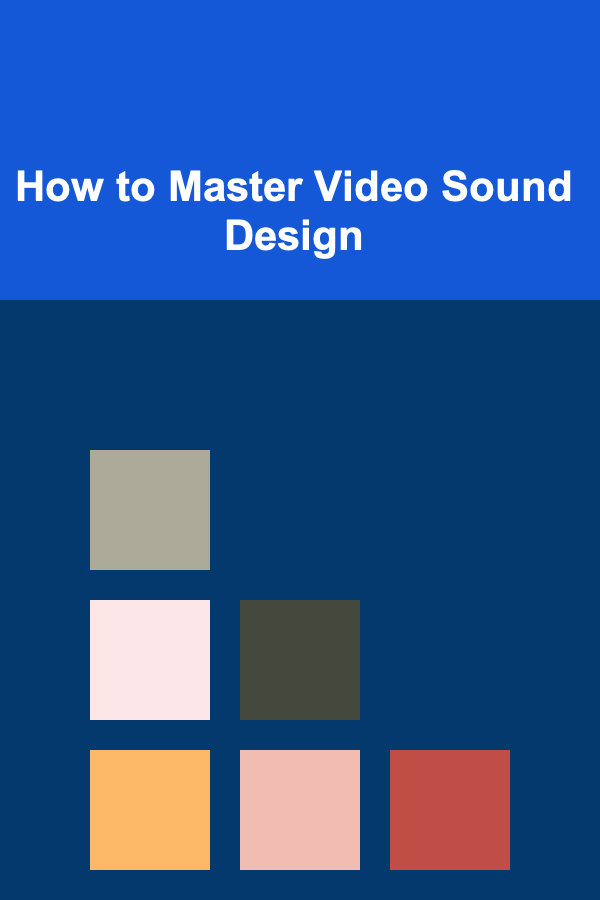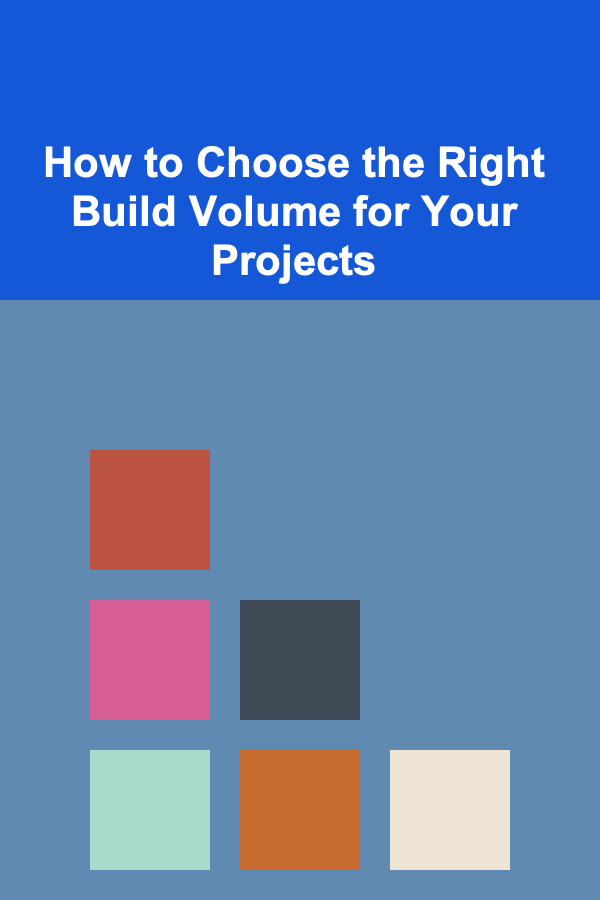
How to Master Video Sound Design
ebook include PDF & Audio bundle (Micro Guide)
$12.99$8.99
Limited Time Offer! Order within the next:

Sound design is an integral aspect of filmmaking, gaming, and any other form of multimedia content creation. It's often said that sound is half the experience. While visuals draw the audience in, it's sound that immerses them in the world you're creating. Whether it's a subtle ambiance that sets the mood or a dramatic crescendo that heightens tension, sound design has the power to shape how a viewer or player experiences a story.
In this article, we'll explore how to master video sound design, breaking down the process into essential steps and providing techniques to help you create the most engaging and impactful soundtracks for your projects. From understanding the basics of sound to mastering advanced techniques and technologies, this guide is designed to provide you with a comprehensive roadmap.
Understanding the Basics of Sound Design
Before you dive into the creative process of sound design, it's essential to understand what sound design entails and how it interacts with visuals. At its core, sound design is the art of creating and manipulating audio elements to support the narrative of a video, game, or film.
What is Sound Design?
Sound design involves creating, recording, and manipulating audio elements that are used to accompany visuals. This includes dialogue, sound effects, music, and ambient sounds. Each of these elements works in harmony to enhance the emotional impact of a scene, convey a sense of time and place, and add realism to the visual content.
There are several layers in sound design, including:
- Dialogue: The spoken words of the characters, which are essential for storytelling.
- Sound Effects (SFX): These include all non-dialogue sounds, like footsteps, doors creaking, or distant thunder. SFX play a crucial role in making the visuals feel real and immersive.
- Foley: Named after Jack Foley, the technique of recording live sound effects that are synchronized with the visuals (e.g., footsteps, rustling clothes).
- Ambience: Background sounds that provide context to the setting, like the hum of a busy street or the wind rustling through trees.
- Music: The soundtrack that complements the mood, tone, and pacing of the video. Music helps guide the emotional direction of a scene.
The Role of Sound in Video Production
Sound design is more than just adding noise to fill the silence. It has the power to affect the audience's perception of what's happening on screen. Proper sound design can:
- Set the Tone: A scene's mood is significantly influenced by sound. For example, a tense scene may benefit from a low, rumbling sound or high-pitched tones to increase the tension. Conversely, a lighthearted scene might have cheerful music or whimsical sound effects.
- Enhance the Story: Sound is a storytelling tool. It can help establish character traits, build the world, and provide important narrative cues that visuals alone might not be able to express. For instance, the sounds of a bustling city can give context to a character's loneliness or a bustling marketplace scene.
- Create Atmosphere: Ambience is vital in setting the environment of the scene. Whether it's the sound of an eerie forest or the hum of a futuristic spaceship, ambiance anchors the visuals in a specific time and space.
Key Sound Design Techniques
Mastering sound design requires familiarity with several key techniques that help bring your ideas to life. The following techniques form the foundation of successful sound design.
1. Layering Sounds
One of the most fundamental techniques in sound design is layering. This involves combining multiple sound elements to create a fuller, richer soundscape. The layers can include dialogue, music, ambient sounds, and sound effects. The key is to ensure that these elements work together to enhance the visuals rather than compete with each other.
For example, if you're designing a scene where a character is walking through a forest, you might layer the following sounds:
- Footsteps: The sound of the character's shoes hitting the forest floor.
- Rustling Leaves: The ambient sound of wind or the character brushing past foliage.
- Animal Sounds: Background noises of birds chirping or distant animals to enhance the environment.
- Music or Drones: Subtle background music to set the mood or add tension, especially if the scene is intended to be suspenseful.
By layering these sounds, you create a complex and immersive experience that feels more realistic.
2. The Power of Silence
While it may seem counterintuitive, silence is one of the most effective tools in sound design. Silence can be used strategically to create contrast, build suspense, or highlight a particular moment. For example, before an explosion or a sudden action scene, removing sound or reducing the volume can create a sense of anticipation and heighten the impact when the sound returns.
3. Creating Unique Sound Effects
Sometimes, the most memorable moments in sound design come from creating entirely new sounds. In many cases, you might need to design sounds that don't naturally exist in the world. This is where creativity and experimentation come into play.
For instance, the sound of a spaceship's engine might not exist in the real world, so you'll need to create a synthetic sound. This can be done by blending elements from various sources---such as the rumble of a diesel engine, the hum of a computer, and synthesized tones---until you arrive at the perfect sound.
The process of creating unique sound effects often involves:
- Recording Sounds: You might go out into the world and record sounds that you can later manipulate and transform. This could involve anything from recording a metal object scraping across the floor to capturing the sound of water dripping into a sink.
- Sound Manipulation: Once you've recorded your sounds, you can manipulate them using software to pitch-shift, reverse, or distort them. By combining multiple elements and applying various effects, you can create something completely original.
4. Re-recording Sounds: The Art of Foley
Foley is an essential technique that adds realism to films and videos. It involves re-recording sound effects in sync with the action on screen. Common Foley sounds include footsteps, the rustling of clothing, or the sound of objects interacting (like a door opening or a glass breaking).
The key to effective Foley is synchronization. Every sound must match the on-screen action perfectly. This creates the illusion that the sound is happening in real time, contributing to the immersion of the viewer.
5. Using Sound to Support Storytelling
The best sound designers understand how to use sound to support and enhance the storytelling. For example, specific instruments or sound textures might be used to signal a character's emotional state. A character walking into a dark, unfamiliar place might trigger low, dissonant notes in the music, signaling danger or unease.
Also, consider the genre and setting when designing sound. For example, if you're working on a horror film, you might rely on unsettling, eerie sounds---like distorted whispers or creaking doors---to build tension. On the other hand, for a light-hearted romantic comedy, the sound design might be more upbeat and whimsical, using sounds like laughter, birds chirping, and uplifting music.
6. Mixing and Balancing Sounds
Once all the sound elements have been recorded or created, it's time to mix them. Mixing involves adjusting the volume, panning, equalization, and effects of each individual sound to ensure they work together cohesively. The goal is to ensure that no sound overpowers another and that each element serves its purpose in the overall soundscape.
In the mixing process, you need to pay attention to several factors:
- Volume Levels: Ensure that no sound is too loud or too soft. For example, dialogue should be clear and intelligible, while background music and sound effects should support but not overwhelm it.
- Panning: Panning refers to placing sounds in the stereo field. For instance, the sound of footsteps might come from the left speaker if the character is walking from left to right in the scene.
- EQ: Equalization (EQ) is used to adjust the frequency balance of sounds. For example, you may want to add more low-end to a bass-heavy sound or boost the treble on a higher-pitched sound.
- Effects: Reverb, delay, and other effects can be used to create space and depth in the mix, making sounds feel like they belong in a real-world environment.
Tools and Software for Sound Design
Mastering sound design requires familiarity with the tools of the trade. Here are some popular software and equipment used by professionals:
1. Digital Audio Workstations (DAWs)
A DAW is where most of the magic happens in sound design. Some popular DAWs include:
- Pro Tools: A professional-grade DAW that is widely used in the film and music industry.
- Ableton Live: Popular for music production, but also widely used for sound design, particularly for its flexibility and user-friendly interface.
- Logic Pro X: A comprehensive DAW with a range of tools for sound design, including sample libraries and synthesizers.
2. Sound Libraries and Sample Packs
Sometimes, you won't need to create every sound from scratch. Using high-quality sound libraries can save time and effort. Popular sound libraries include:
- Soundsnap: A vast library of sound effects and loops for film and video projects.
- Boom Library: Known for its cinematic sound effects, including everything from footsteps to explosions.
- Splice: A subscription service offering access to a massive collection of samples for sound design and music production.
3. Audio Editing Tools
In addition to your DAW, you'll need some audio editing tools to manipulate and refine your recordings. Some useful tools include:
- iZotope RX: A comprehensive audio repair and editing suite.
- Audacity: A free, open-source audio editing tool that can handle basic editing tasks.
Conclusion
Mastering video sound design is a journey that requires both technical skill and creativity. By understanding the basics of sound design, applying key techniques like layering and Foley, and using the right tools, you can elevate your videos, games, or films with immersive, emotional, and impactful sound.
As sound designers, your role is not just about making noise; it's about crafting an auditory experience that enhances the visuals and helps tell a compelling story. Whether you're creating a world, enhancing a scene's atmosphere, or evoking emotions, sound design is a powerful tool that can turn an ordinary project into something extraordinary.
With practice, patience, and an understanding of the principles and techniques outlined above, you can master the art of sound design and create immersive audio experiences that captivate your audience.

Healthy Doesn't Have to Be Expensive: Cheap and Healthy Meal Ideas for All
Read More
How to Build Strong Relationships with Remote Colleagues
Read More
How to Choose the Right Build Volume for Your Projects
Read More
How to Craft a Resume That Gets Noticed
Read More
How to Plan a Home Budget for a Growing Family
Read More
How to Use a Whiteboard for Planning and Brainstorming
Read MoreOther Products

Healthy Doesn't Have to Be Expensive: Cheap and Healthy Meal Ideas for All
Read More
How to Build Strong Relationships with Remote Colleagues
Read More
How to Choose the Right Build Volume for Your Projects
Read More
How to Craft a Resume That Gets Noticed
Read More
How to Plan a Home Budget for a Growing Family
Read More